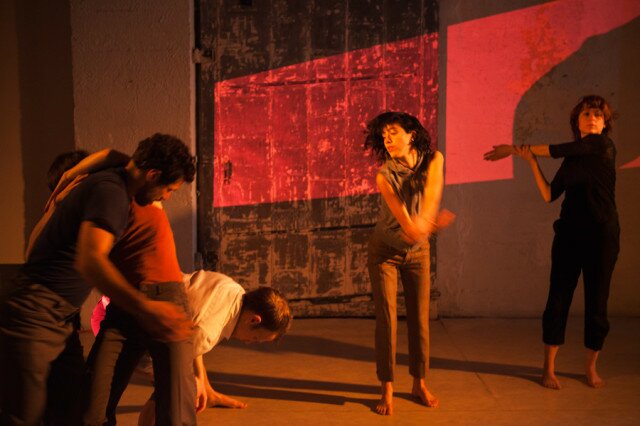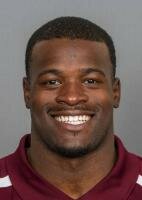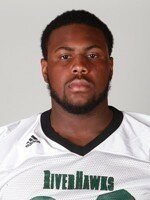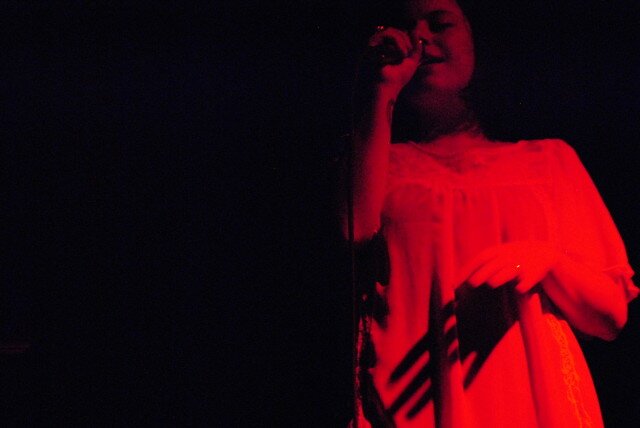
lwestcoat captured a recent sunset during a serene spring evening on a local body of water. And yes, we do notice the full moon…don’t you?

lwestcoat captured a recent sunset during a serene spring evening on a local body of water. And yes, we do notice the full moon…don’t you?
Green Chair Dance Group‘s Tandem Biking and Other Dangerous Pastimes for Two ends the SCUBA 2013 program at Velocity Dance Center (through April 28; tickets) but as they are visitors to Seattle, let’s talk about them first. That way we can get right into how they quirkily talk the audience through an “inside look” at a three-person dance troupe and their interpersonal dynamics.
That the explanations are often unclear, gnomic, or non sequiturs takes nothing from the earnest helpfulness with which they share the names of various pieces (“We Are Reasonable People,” “We Are Luscious People,” “We Are Desperate People”), announce the rationale for their order (the favorite one comes first), or instruct the audience that the games they’ll be playing, however, are “real” (immediately undercut by Sarah Gladwin Camp letting everyone in on the fact that de Keijzer’s game is wearing natural fabrics: cotton, organic cotton; while she, Gladwin Camp likes to play “Don’t Touch My Face,” a game inspired by the fact that she doesn’t like water or people touching her face, and which is indicated by her making a shuffling gesture of disdain with her hands and fingers).
Early on, Gregory Holt gets so carried away with his narration that he mansplains another dancer out of existence, dropping to the floor to show everyone what her dance is like. Dance is decentralized here — or, looked at another way, made so diffuse it permeates everything. Though the work begins with a polished, in-unison phrase that they bring back (seasonally, in swim wear and snow gear) — kicking prettily from a beach-blanket pose, jacking through a turn on their backs by swiveling their hips, hopping to their feet for some stepping — there are also extended, aggressive capoeira-esque bouts, “monument” building where bodies are placed on or jointed into other bodies, and de Keijzer’s contorted face and tongue “dance.”
Gladwin Camp mentions, of a Holt-de Keijzer duet, that it was, for her, like looking through the wrong end of a pair of binoculars. The tension inherent in Tandem Biking for a three-person group gives it both cohesive and propulsive force. De Keijzer says that she’s pretty sure they could all three handle being cooped up in one small room for years, so long as, on a rotating basis, one could leave to have some time alone. The flip-side of that is when one watches as the other two perform. Gladwin Camp emerges bundled up like the kid from A Christmas Story, and it’s both a metaphor for a sort of bruised tenderness, and not a metaphor at all, but a wintertime reality.
Maureen Whiting‘s About That Tree, with its painted-face dancers in tunics and pelts, seemingly living among or caught by the battered branches of a fallen tree, swiftly generates an atmosphere that, this particular year, might remind you of Rite of Spring‘s mythic primitivism. There’s not a lot of spring to be seen, though — the tree has fallen, and a bag of dusty, dead leaves is emptied onto the stage (costume and visual design are by Danii Blackwell and Jean Hicks). Music by Dave Abramson, Eyvind Kang, and Evan Schiller, in vastly different idioms, fits perfectly with the choreography for a 14-person ensemble.
When I saw an excerpt in rehearsal, Whiting was still determining if the “center would hold,” in terms of there being a focal point for the audience — 14 dancers is a lot to attend to. But she’s pulled it off without resorting to strict unison movement that might dampen the individuality expressed by her dancers. She uses breathing, and the sound of it, to move your attention; competing rhythms arise and generate a sort of group “breath” — or not. At one point, a dancer grabs the tree and holds a chunk aloft, another begins a solo with a sort of switch, another balances small branches on her shoulders, head, in the small of her back. The piece ends with a dancer, having grabbed the tree for herself, dropping it to let its clatter disrupt the breathy group communion.
This world premiere is a work you may want to see — and hear — a few times. There’s a poetic compression to it that leaves you wanting more.

I had a similar feeling about the excerpt from Shannon Stewart‘s An Inner Place That Has No Place, which I saw an earlier version of a year ago. Here, what had been the last segment came first — dancers Meredith Horiuchi, Mary Margaret Moore, Aaron Swartzman, Rosa Vissers, and David Wolbrecht start off with a high-energy routine, complete with whoops of theoretic delight, that evokes a workout class’s slightly manic pace (music is by composer Jeff Huston).
Initially, the movements are both mechanically precise and slightly cliché, Broadway-musical-style, but then the dancers start shouting out icebreaker-style questions to each other about their pasts that get a litte intrusive (“Where did you lose your virginity?”) and as answers are given, the strict cohesion falters and they start interacting with each other with more idiosyncratic movement. But later, they’ll group around a single dancer and barrage him or her with questions, bumping up against, until the person seems to pass out, so it seems that perhaps moderation is key.
Behind the troupe, a striking video projection (courtesy filmmaker Adam Sekuler) shows them repeating into infinity — this later changes into an expanse of night sky that feels both beautiful and ominous, with a single dancer left. In a middle segment, the troupe poses for a series of memory-photographs, in ways that are both satirically funny (they look to be drunken party shots) and increasingly eerie, as the dancers’ expressions freeze into rictuses or slowly melt away. Even in excerpted form, the work packs a punch that you’re never quite ready for, as its set-ups veer off down unanticipated alleys.
The Philosophy
“As we looked at our team and we looked at the guys on the draft board we knew it was going to be a challenge to take guys because we like the players we have. The depth charts are situated well, and they’re young, and they’re just reaching the prime of their playing time. I look at is as hoping we can add a competitive nature to the position, and that’ll bring out the best in everybody that’s there.” —Head coach Pete Carroll
The Picks
 Christine Michael, RB – Round 2, #62 overall (@CMike33)
Christine Michael, RB – Round 2, #62 overall (@CMike33)
Fun Fact: Ejected from a game last season after punching an opposing player.
“He’s our kind of runner. He’s a tough, intense, one-cut upfield guy. You don’t know if he’s gonna try to make you miss or run into ya.” —General manager John Schneider
“We ran the ball more than anybody in the NFL last year, so we want this position loaded up.” —Carroll
“You can’t go through drafts passing on talents like Michael. When you start doing that is when you start to make a lot of mistakes.” —Schneider
“He’s an explosive NFL back. He’s a traditional one-cut downhill guy. Marshawn has a little more slide. Christine is: ‘Downhill now.’” —Area scout Matt Berry
“Seattle was going to find it difficult to make a tangible improvement to the team without a round one pick this year. By taking Michael, they managed it anyway.” —Rob Staton, Seahawks Draft Blog
“Michael has the athleticism, size, and physical upside of Adrian Peterson. He even looks like AP a little bit. And as I found out today, they both spent time doing offseason workouts together in Texas. Peterson has better lateral agility and doesn’t have a fumble problem, but in terms of physical dominance, Michael’s potential is sky high.” —Kip Earlywine, Seahawks Draft Blog
“Michael might be the most talented back in this class. If Seattle can keep him focused, Michael has a chance to be a steal at this point.” —ESPN
Similar Picks: Golden Tate (#60, 2010); Darryl Tapp (#63, 2006); Anton Palepoi (#60, 2002); Bob Jury (#63, 1978); Steve Raible (#59, 1976); Jeff Lloyd (#62, 1976).
 Jordan Hill, DL – Round 3, #87 overall (@J_HILL_47)
Jordan Hill, DL – Round 3, #87 overall (@J_HILL_47)
Fun Fact: Led high school team to two Pennsylvania state championships.
“He’ll be right in the rotation. We’ve been trying to get more activity inside and this is the guy we thought was one of the best players in the draft at creating space inside.” —Carroll
“He can get up the field and be disruptive and is really quick laterally. That was a hole for us.” —Schneider
“Hill is a high-floor, low-ceiling option at defensive tackle. He’s good for a few nifty plays a game in the backfield, but he’s not a dominant force. In terms of upside, there were many other DTs who are better that Seattle passed on for Hill.” —Kip Earlywine, Seahawks Draft Blog
“Hill isn’t overly physical, which means his early contributions will be in sub packages.” —ESPN
Similar Picks: Brandon Mebane (#85, 2007); David Greene (#85, 2005); Kris Richard (#85, 2002); Dean Wells (#85, 1993); Chris Warren (#89, 1990); Rickey Hagood (#86, 1984); Scott Phillips (#84, 1981); John Yarno (#87, 1977), Rick Engels (#89, 1976).
 Chris Harper, WR – Round 4, #123 overall (@THEChrisHarper)
Chris Harper, WR – Round 4, #123 overall (@THEChrisHarper)
Fun Fact: Started college career as a QB at Oregon.
“He’s a big, strong, physical receiver. We like that element, that’s different than the guys we have. We see him as an outside receiver.” —Carroll
“Former quarterback with a good understanding of the passing game but still developing as a route runner.” —ESPN
“He has enough speed to threaten the big play and the strength to shield defenders from the ball, often coming through with tough grabs with corners draped over him.” —Rob Rang, NFLDraftScout.com
“I’ve only been (playing WR) three years. I’m still new but it feels more natural now.” —Chris Harper
“He’ll be a versatile weapon in the offense – he’s played inside and out in Kansas State’s offense – and his downfield blocking must have been super attractive to the Hawks.” —Danny Kelly, Field Gulls
“Harper is the size of MLB Bobby Wagner … 6-0, 234 pounds.” —Dave Boling, Tacoma News Tribune
“Love it!!! This guy is 230 lbs with speed! Over 6 feet!” —@DavisHsuSeattle
Similar Picks: Red Bryant (#121, 2008); Mansfield Wrotto (#124, 2007); Gary Dandridge (#122, 1992); Mark Napolitan (#123, 1985); Chris Castor (#123, 1983); Randy Johnson (#122, 1976); Andy Bolton (#123, 1976).
 Jesse Williams, DT – Round 5, #137 overall (@TheMonstar)
Jesse Williams, DT – Round 5, #137 overall (@TheMonstar)
Fun fact: Born and raised in Australia, didn’t play football until he was 14.
“He’ll fill a specific role for us. His strength and his ability to compress the cockpit is really intriguing to us.” —Schneider
“We’d like him to play three-technique. We think he’ll play a lot of first and second down and we’ll see how he can push the pocket on third down.” —Carroll
“A disruptor but not a finisher. Has a little bit of upside if he continues to improve array of pass rush moves and develop a better pass-rushing gameplan.” —ESPN
“Williams isn’t going to pressure the quarterback often but his size and strength will make him a force in the middle.” —Rob Rang, NFLDraftScout.com
“Seahawks get first-round quality DT Jesse Williams in the fifth round? Of course they do.” —Will Brinson, CBS Sports
“Run-stopping is my strength. Hopefully in the NFL I’ll get a better chance at pass rushing.” —Jesse Williams
“The perfect example of the deep talent pool at defensive line in this year’s draft. At 6-3 ½ and 323 pounds, Williams is a powerhouse inside, demonstrated by his 600-pound bench press.” —Eric Williams, Tacoma News Tribune
Read more here: http://blog.thenewstribune.com/seahawks/2013/04/27/seahawks-select-dt-jesse-williams-at-no-137-cb-tharold-simon-no-138-pick-in-fifth-round/#storylink=cpy
“You’re always looking for the guy whose best football is ahead of him. My hunch is that Williams may be one of those guys.” —Danny Kelly, Field Gulls
 Tharold Simon, CB – Round 5, #138 overall (@t_simon24)
Tharold Simon, CB – Round 5, #138 overall (@t_simon24)
Fun Fact: Got arrested the Thursday before the draft for allegedly threatening a cop.
“Very long, very aggressive, should fit in very well. He’s coming in to compete outside.” —Carroll
“Good-sized athlete with quick read/react skills. Long arms and uses his reach to make plays on the ball. Not a quick-twitch athlete and lacks elite long-speed.” —NFLDraftScout.com
“I know exactly how (the Seahawks) play. They like tall physical corners. They like to press.” —Tharold Simon
“A right side corner – likely the long-term successor to Brandon Browner.” —Danny Kelly, Field Gulls
Similar Picks: Solomon Bates (#135, 2003); Alex Bannister (#140, 2001); Floyd Wedderburn (#140, 1999); Johnnie Jones (#137, 1985), Steve Durham (#140, 1981).
 Luke Willson, TE – Round 5, #158 overall
Luke Willson, TE – Round 5, #158 overall
Fun Fact: Played on the Canadian national junior baseball team alongside current Blue Jay Brett Lawrie.
“For us, the second-best tester of all the tight ends in this draft.” —Schneider
“We think he can get down the field for us, but we’d really like to develop him to do everything.” —Carroll
“(Had) a stellar workout at Rice’s pro day. Wilson posted a 4.49 forty-yard dash time paired with 23-reps on the bench press and a 38-inch vertical leap.” —Roni Wade, Pro Player Insiders
“Athletic tight end prospect with a large upside. Must commit to football and find a team willing to develop his skills” —Draft Insider
“He’s going to be a guy who can give us a downfield threat from that tight end position.” —Seahawks area scout Ed Dodds (via Eric Williams, Tacoma News Tribune)
Similar picks: Mark LeGree (#156, 2011); Jeb Huckeba (#159, 2005); D.J. Hackett (#157, 2004); Roy Hart (#158, 1988); Larry Bates (#156, 1976); Al Darby (#157, 1976).
Spencer Ware, RB – Round 6, #194 overall (@spenceware11)
Fun Fact: 2nd LSU underclassman taken by Seahawks (Simon).
“He’s such a tough guy. I think he really fits the style. We’re hoping that we can groom him as a fullback who can play tailback.” —Carroll
“Runs with a purpose. Plays the game with passion and energy.” —ESPN
“Valuable on third down. A willing blocker and skilled receiver with soft hands and better than average athleticism.” —Billy Gomila, SBNation
“(Ware) ran the 40-yard dash in 4.62 and 4.63 seconds. He posted a 34 inch vertical leap and a 10-foot-1/2 inch broad jump. Ware had a good workout on the day, and caught the ball exceptionally well.” —Gil Brandt, NFL.com
“A solid interior runner who can line up in a power-running offense or be used as a short-yardage back at the next level.” —Draft Insider
“With the backfield getting a bit crowded…(Michael) Robinson’s role and cap hit begins to come into question. Ware is a logical fullback convert, a role he played at times at LSU. Ware is a fantastic pass-catcher out of the backfield and as a former HS Quarterback, has been schooled in reading defenses, similar to Robinson.” —Danny Kelly, Field Gulls
Similar picks: Tony Jackson (#196, 2005); Craig Jarrett (#194, 2002); Ron Mattes (#193, 1985); Eric Lane (#196, 1981).
Ryan Seymour, OG – Round 7, #220 overall (@SEYMONSTER62)
“Fun” Fact: Moved from defensive line to offense early in college career.
“We talk about smart, tough, reliable, and that’s what he is.” —Schneider
“Quick enough to reach front side three-technique and cut off backside one-technique in zone scheme.” —ESPN
“Played effectively at several of line positions, taking snaps at center, guard and tackle.” —Vanderbilt Athletics
Similar picks: Josh Brown (#222, 2003); Dennis Norman (#222, 2001); Judious Lewis (#221, 1985).
Ty Powell, DE – Round 7, #231 overall (@tytan9)
Fun Fact: Was a QB in high school and led his team to a California state championship.
“We like the athleticism and the speed he brings.” —Schneider
“Ranked among the most explosive in his position group in the vertical jump (37″) and three-cone drill (6.98-seconds).” —Rob Rang, NFLDraftScout.com
“Very high ceiling as a pass rusher. Possesses a quick first step.” —ESPN
Similar picks: Greg Scruggs (#232, 2012); Justin Forsett (#233, 2008); Steve Vallos (#232, 2007); Jeff Kelly (#232, 2002); Rich Grimmett (#231, 1978).
Jared Smith, OG – Round 7, #241 overall (@unhsmitty90)
Fun Fact: Played defense in college, Seahawks will convert him to guard like they did with J.R. Sweezy.
“We’re excited about his upside from an athletic standpoint. Very similar mold as Sweezy.” —Schneider
“Hits all the marks in terms of height, weight and top-end speed. Average arm length (33.5).” —ESPN
“I will always feel that I need to prove to everyone why I belong, but I like having that pressure on me because I know that I will work harder than anyone. Working hard is in my nature from being a New Hampshire Wildcat and I am willing to prove that to anyone.” —Jared Smith
“(Smith) earned the nickname ‘Fat Rabbit’ for his surprising speed and agility within an outsized frame.” —Louis Bien, SB Nation
“As long as (switching positions) gets me to where I’m going, I’m going to work very hard.” —Jared Smith
 Michael Bowie, OT – Round 7, #242 overall (@61likebowie)
Michael Bowie, OT – Round 7, #242 overall (@61likebowie)
Fun Fact: Started college career at Oklahoma State, was dismissed for violating undisclosed team rules.
“Big, athletic, great feet, long arms. Has a bit of a background, if he overcomes that has a chance to be a great pro.” —Schneider
“He’s the type of guy they call a developmental swing lineman prospect.” —Mike Mayock, NFL Network
“Bowie has a massive frame, and a lot of upside in terms of athleticism and natural power. However, he is raw.” —ESPN
Similar picks: Malcolm Smith (#242, 2011); Ryan Plackemeier (#239, 2006); Deatrich Wise (#242, 1989); M.L. Johnson (#243, 1987); Adam Schreiber (#243, 1984); Ezra Tate (#240, 1979); Bob Bos (#239, 1976).
The Undrafted Free Agents
Matt Austin, WR, Utah State: “A big, physical wide receiver with great hands.” [USU player page]
Alvin Bailey, OT, Arkansas: “Blessed with a natural anchor to limit his opponent’s opposition.” [NFL draft page]
Kenneth Boatright, DE, Southern Illinois: “Was 26th nationally in TFLs per game (1.23).” [SIU player page]
Ramon Buchanan, LB, Miami: “Was one of the top defenders out of Florida as a recruit.” [CBS draft page]
John Lotulelei, LB, UNLV: “A thick OLB (with) quickness and closing speed.” [NFL draft page]
Ray Polk, SS, Colorado: “Ran the 40 at 4.40 and had a 39-inch vertical jump.” [NFL draft page]
Jordon Roussos, OG, Bowling Green: “BGSU’s offensive line allowed just 13 sacks all season.” [NFLDraftScout page]
Dominique Whaley, RB, Oklahoma: “Walk-on turned into team’s starting RB.” [OU player page]
Craig Wilkins, LB, Old Dominion: “ODU’s all-time leader in tackles, sacks, forced fumbles, and interceptions.” [ODU player page]
On Sunday, April 28th, local music label Neon Sigh hosts another neon pop bill. Golden Gardens headlines the set with Nostalgist, Snowdrift, and The Echo Echo Echoes. Doors at 7:30 p.m. at The Sunset Tavern in Ballard, 5433 Ballard Ave NW, $6 cover.

Stirred together, the members of Seattle’s Golden Gardens are a double-helix of fuzzy, milky, dreamy shoegaze splendor. Aubrey Rachel Violet Bramble (vocals) and Gregg Alexander Joseph Neville (guitar, drums, and effects) have some magical new melodies up their sleeves that they can’t wait to share. They’ll premiere tunes from an EP to be released in early June.
Also gracing the stage, with sultry haunt rock, noirgaze, and ambient surf pop, are Snowdrift, Nostalgist, and The Echo Echo Echoes — respectively. Come out and sway.
If you prefer couch-potato sweatpants Sundays, you’ll have another chance to slather your ears in Golden Gardens’ ganache next month. They play the Columbia City Theatre with Tokyoidaho on Friday, May 17th. Rumor has it there’s going to be a ticket giveaway.
Eugene O’Neill revolutionized theatre in America. He was seen as our first original voice standing shoulder to shoulder with Ibsen and Chekhov, and, like Ibsen and Chekhov, his language is formal, lyrical, almost verse. He also worked in vernaculars that sound far from natural today.
O’Neill pursued challenging forms including attempts to create an American version of classical Greek tragedy. He dealt with big issues that often remain topical if not relevant 100 years later. Many of his works can feel melodramatic or unintentionally campy. In fact The New York Neo-Futurists intentionally mined laughter from a production that cut everything but the stage directions from several O’Neill plays. The biggest question facing anyone attempting to produce O’Neill is how does one sell Eugene O’Neill to today’s audiences?
Director Wilder Nutting-Heath provides an incomplete answer to this question in Ghost Light Theatricals’ production of The Hairy Ape (at Ballard Underground through May 5). This Expressionist play has a storied production history, from a London production featuring Paul Robeson in the title role, to the Wooster Group production with Willem Dafoe. It is man-against-society, the rage of the forgotten classes.
In a time when the disenfranchised are starting revolutions and committing acts ranging from civil disobedience to terror, this script could make for a vital theatrical event. But though this production does a lot of shouting, we don’t feel the fury — or much of anything else, for that matter.
The show begins with a choreographed depiction of life in the boiler room of a steam ship, effectively, Stomp with shovels. Richard Carmen establishes the central character of Yank with a bravado worthy of hip-hop. The play tracks the unraveling of that self-assurance into a loss of identity, then final destruction. A chance encounter with a socialite shakes Yank’s identity and topples him from the highest levels of society — to a jail cell, to the Wobblies, and to the zoo.
Subtitled “A Comedy of Ancient and Modern Life in Eight Scenes,” this production misses the comedy almost entirely in large part because it misses the Expressionist side of the production. As O’Neill notes in the play’s opening stage directions: “The treatment of this scene, or of any other scene in the play, should by no means be naturalistic.” Correspondingly, the most naturalistic scenes in this production are the biggest failures. Nutting-Heath occasionally allows his ensemble to leave the confines of realism and tiptoe into abstraction. Unfortunately they do so with such timidity that the effect is nearly lost. The Fifth Avenue promenade scene with its wind-up socialites comes closest to the fulfilling the script’s needs, but even this feels hesitant.
The ensemble is consistent and never overshadows the hero. Carmen portrays Yank with impressive energy, which he expresses both physically and vocally, mostly by shouting. This delivery varies little throughout the show. It’s as if a fire hose of verbosity has been turned on the audience.
The actual hairy ape in this production is nicely portrayed in shadow puppetry. Glimpses of the puppet creating that shadow provide the kind of half-revealed insights that might enliven some other script. This play doesn’t go in for subtlety; it requires strong contrasts. Even the puppet is lost to monotony as the looming image never risks a lively stillness but heaves incessantly like an antique medical ventilator.
There is an acting class adage never to let your work be visible. Nutting-Heath claims to have applied psychodrama techniques to this production (and I have argued in the past that psychodrama offers useful training and directing techniques that may result in more immediate and fulfilling performances), but in this case, such techniques would be more useful unmasked, adage or not. Any of the spontaneity or audience connection associated with psychodrama (a relative of group therapy and role-playing exercises) is missing here. A profitable balance might be found between visceral, emotionally-connected acting and stylized performance, but it isn’t evident in this production.
I knew nothing walking into Once Upon a Time 6X in the West at the University of Washington Jones Playhouse (through April 28; tickets) except that Artistic Director of On the Boards, Lane Czaplinski, was a “co-conceiver” of the piece. (They had me at Lane, as it were.) What followed was a performance that defies traditional norms of theatre while exploring the classic and new voices in performance theory and style.
The title actually says a lot. This a Western. It’s a musical. It’s going to be performed in a variety of ways. Sometimes it makes sense. Sometimes it doesn’t. And sometimes, it makes a kind of sense the way that a child’s story kind of makes sense even if it involves a lot of tangential information and subplots that distract from your black hat/white hat characters, and aliens.
In typical Western style, we are introduced to a hard-nosed criminal, El Gaucho (Patrick Baxter), the last man standing in a saloon fight gone wrong. He makes a choice to save the only other survivor — a baby girl. El Gaucho turns from the life of crime to raise her. But, alas alack, she’s kidnapped. (It happens.)
The years pass and the story continues with daughter Lil (immaculate Sylvia Kowalski) and papa trying to reunite. In the process Lil meets a slew of vagabonds and, of course, whores cause she’s a chick in the West. And there’s musical numbers. ‘Cause there are. The script alone is filled with melodrama and camp, which would make anyone with a soul happy enough, but director and writer Jeffrey Fracé applies his own academic twist.
The story is broken into six acts (though they are all relatively short) and every act has a “style” or generator of a theatrical movement associated with it. There are well-known names like Peter Brook, Growtowski, The Wooster Group, and the absolutely amazing Gob Squad (which of course you saw at On The Boards a few months back because you were a smart, smart person).
These sections of storytelling shift between moving and purposefully melodramatic with long nods and nudge, nudges at their inspirations. Particular moment of note in the first act would be the Growtowski-intoning style in “Home in Babylon” and the overly articulated character movements especially for the Madam (Mary Hubert).
There’s also a Mabou-Mines (who I won’t pretend I know) section, which ended Act One and a Robert-Wilson (of Einstein on the Beach fame) section, which started Act Two. Their placement is a disservice to the story and therein lies the problem with Once Upon a Time 6X in the West. These creators, brilliant in their own right, do not apply well to a traditional, linear story structure. More than that, they just appeared to be less fun. When these acts occur, the whole audience appeared to go into a sleepy trance. It killed the momentum and mostly lost whatever story remained.
I’m guessing this lack of momentum is why they thankfully chose to end the show with back-to-back Wooster Group and Gob Squad/Ridiculous Theatrical Company acts. The energy shift on stage was enough to refocus the audience even if it was a rapey-scene that used the phrase “pig fuck” repeatedly.
However, the sigh of relief didn’t last long. Just like Gob Squad, they picked people out of the audience to act the roles in one of the last scenes. (I was suddenly very happy to be sitting in a difficult-to-reach area.) Unlike with Gob Squad, you are not eased into audience participation and the tension that came from many patrons trying to make themselves very small was nerve-wracking. Despite the odds, it worked even if it didn’t hit the same emotional tenor Gob Squad achieved.
But it’s in the final moments with video projections of Lil that you not only get to see Kowalski shine, but also find the heart of Once Upon a Time 6X in the West. This movie moment and the song “What’s After Goodbye” which followed were absolutely touching. There the play should have ended. But it didn’t. The real ending was muddled and unnecessary and long considering “What’s After Goodbye” sounded very much like a closing song.
The nice thing about university theatre productions is that the audience is usually on board for a spectacle they’d never see at a “traditional” theatre. Universities and colleges don’t have to worry about subscribers in the same way that non-profit theatres do. (I still hear patrons talk about walking out of the Sarah Kane play performed at ACT a few years ago, or canceling their subscriptions over “questionable artistic choices” for others.) Universities can take risks; so I’m pleased when they actually do instead of choosing another performance of Neil Simon or [insert some other irrelevant playwright here].
But university productions face a different question: Does it stand on its own past an academic lens? In the case of Once Upon a Time 6X in the West the answer is, enh. It’s unusual and interesting, but the tone of it is more like a grad student’s senior thesis in theory exploration rather than a compelling night of theatre. Though entertaining and even thought-provoking at times, its scattered historical trek through brilliant theatremakers does not always serve its story or the styles to which it pays homage. One is left with the impression that while the production tried to seek its own style through the exploration of others, somewhere it got drunk in the saloon and forgot to forge its own path in the wilderness.